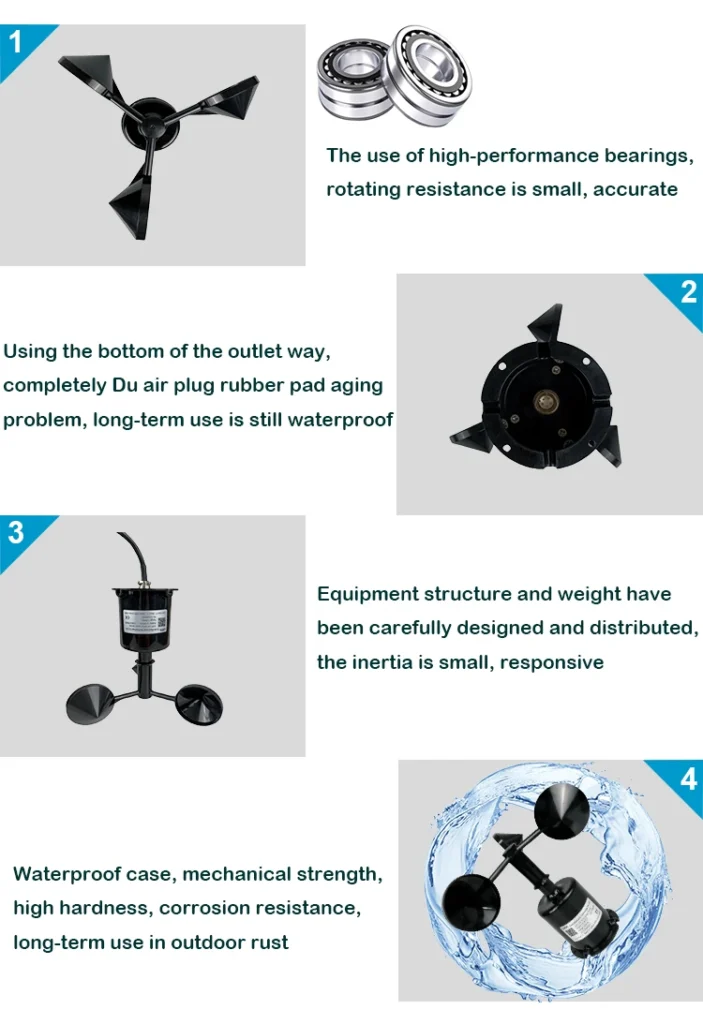Why Regular Maintenance is Important for Cup Anemometers Longevity and Precision
Introduction:
Routine maintenance is very important for keeping cup anemometers durable and accurate. These tools measure wind speed and are essential for meteorologists, engineers, and wind energy experts. Cup anemometers have three or four cups on a rotating shaft. Without regular care, they can become less accurate or fail early. This article explains why regular maintenance is needed to extend the life of cup anemometers. It also shares key practices for effective maintenance.
The Importance of Routine Maintenance
Keeping a cup anemometer accurate and working well is important for collecting reliable wind data. Regular maintenance helps ensure it performs at its best. It also allows for early detection and fixing of any problems. Here are the main reasons why maintenance is essential:
1. Maintaining Accurate Measurements
Regular maintenance helps cup anemometers give accurate readings. Over time, dirt, dust, and debris can build up on the cups. This buildup can interfere with their rotation and cause wrong readings. Harsh weather, like rain, snow, or extreme temperatures, can wear down the device. This wear can also affect accuracy. Routine upkeep, like cleaning parts and recalibrating sensors, reduces these problems. It helps keep measurements accurate.
2. Prolonging Operational Lifespan
Proper maintenance greatly increases the lifespan of cup anemometers. By fixing wear and tear with regular inspections, users can stop early failures. Tasks like lubricating moving parts, checking cables for damage, and replacing worn pieces help keep the device working well. This way, the anemometer stays efficient longer. It reduces how often replacements are needed and saves money over time.
3. Promoting Cost-Effectiveness
Routine upkeep is a smart way to save money compared to ignoring maintenance. Poorly maintained anemometers can give wrong data. This can cause financial losses or bad decisions in industries that rely on wind measurement. Regular inspections help prevent unexpected breakdowns or errors. This helps organizations avoid extra repair or replacement costs and keeps operations running smoothly.
4. Enhancing Safety and Reliability
Safety and reliability are very important when managing cup anemometers. These devices are often placed in hard-to-reach areas like rooftops, offshore sites, or tall buildings. Regular maintenance checks help ensure the device and its installation are safe. This reduces risks to people and property from failures. Routine care keeps the system running smoothly. It provides reliable wind speed data that stakeholders can trust.
5. Ensuring Compliance with Quality Standards
In industries like renewable energy, aviation, and construction, wind speed data is very important. It affects key decisions. Following quality standards is essential. Regular maintenance helps ensure these standards are met. It checks the device’s accuracy and reliability. By following manufacturer guidelines and doing regular inspections, users keep their professional credibility. They also meet industry benchmarks and avoid expensive regulatory issues.
Essential Maintenance Practices
Taking care of cup anemometers is important for their lifespan, accuracy, and performance. To keep getting correct wind speed readings and use these devices well, follow these key maintenance steps:
1. **Routine Cleaning**
Regular cleaning is important to stop dust, dirt, and other particles from building up on the cups. This buildup can cause extra friction and measurement errors. Use soft brushes or cloths with mild cleaning agents when you clean. Avoid harsh chemicals that could harm the device parts. Keeping the cups clean lowers the risk of contamination and helps ensure steady, accurate readings.
2. **Lubrication**
The smooth operation of the cup anemometer depends on proper lubrication of the rotating shaft and bearings. Following the manufacturer’s lubrication guidelines helps reduce friction and wear. This ensures the cups keep rotating continuously. However, avoid over-lubrication because it can attract debris. This may harm performance. Regular lubrication checks are important for keeping everything working well.
3. **Calibration**
Periodic calibration is important to keep the device accurate. Changes in temperature, mechanical strain, and aging parts can affect anemometer calibration over time. Regular calibration, done according to the manufacturer’s guidelines or with special tools, ensures accurate results. Consulting a professional when needed helps maintain high calibration standards.
4. **Cables and Connections Inspection**
Weather conditions or mechanical stress can damage cables or loosen connections. Regular inspections can help find wear, corrosion, or damage. Make sure all connections are tight and secure. This will prevent wrong data readings from loose or disconnected cables.
5. **Component Replacement**
With long use, important parts like cups, bearings, or shafts may wear out or get damaged. Checking these parts often can help decide when to replace them. Replacing worn-out parts on time ensures the device works well and lasts longer.
**Conclusion:**
Regular maintenance is crucial for keeping cup anemometers accurate and long-lasting. Key steps include cleaning, lubrication, calibration, checking cables, and replacing parts. These actions help ensure reliable wind speed measurements and prevent unexpected problems. Consistent maintenance allows users to use these tools effectively in fields like meteorology, wind energy, and construction. Prioritize maintenance to get the most out of your cup anemometer over the years.
**Innovation in Sensor Solutions**
Improvements in environmental monitoring systems and sensors have greatly increased their use in many areas. This allows OEM production to meet industry needs. Innovation is increasing in the 21st century. Companies like Hunan Coda Electronic Tech Co., Ltd are prepared to lead the market. They will offer new technologies and solutions.
Understanding market challenges and solving them is key to successful sensor solutions. Advanced technology and modern manufacturing improve the quality and performance of these systems. Using these tools helps ensure that sensor solutions stay reliable and meet changing global needs.
